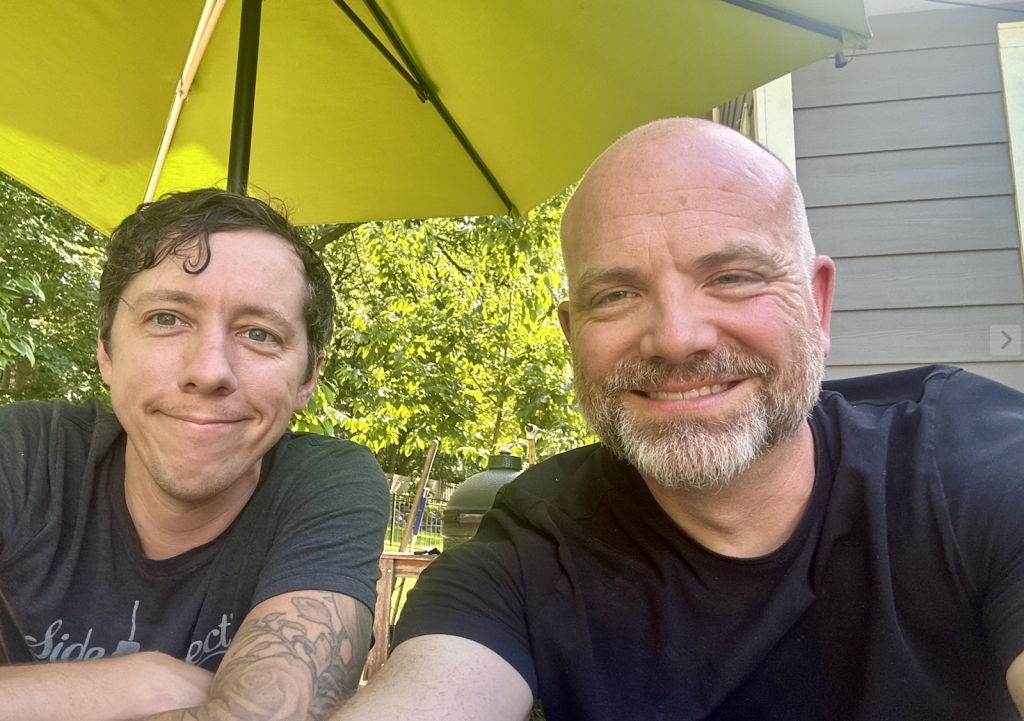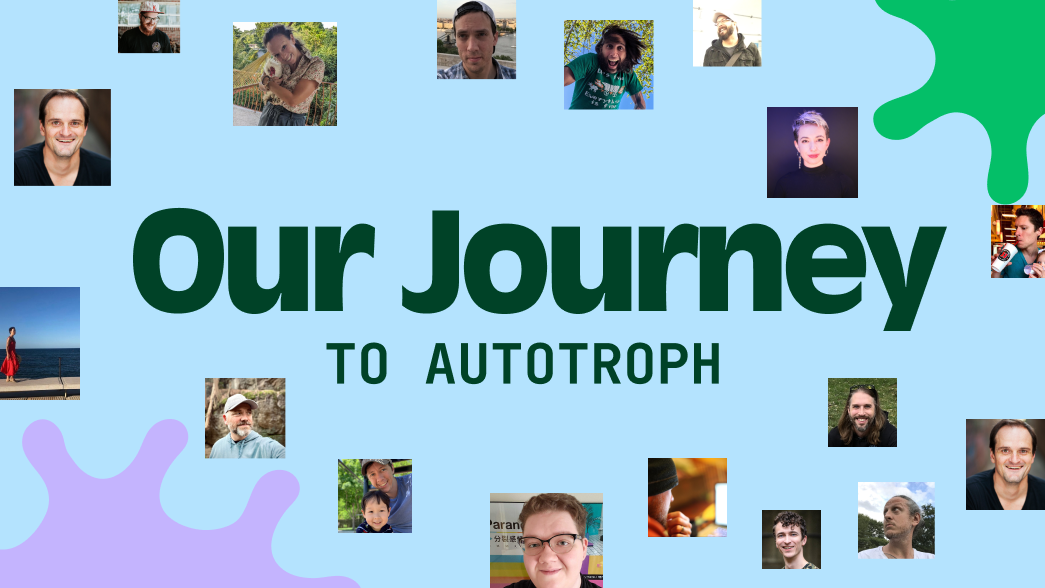The beginning of Autotroph dates back to 2008, when Wes Burke launched cgcookie.com, a small website dedicated to all things computer graphics. There were tutorials, job postings, articles, interviews, and even a gallery.
Wes was coming off a difficult previous year, as his freelance work had dried up. He and his wife were months behind on their home mortgage, their first child had recently been born, and their financial prospects were gloomy to say the least.
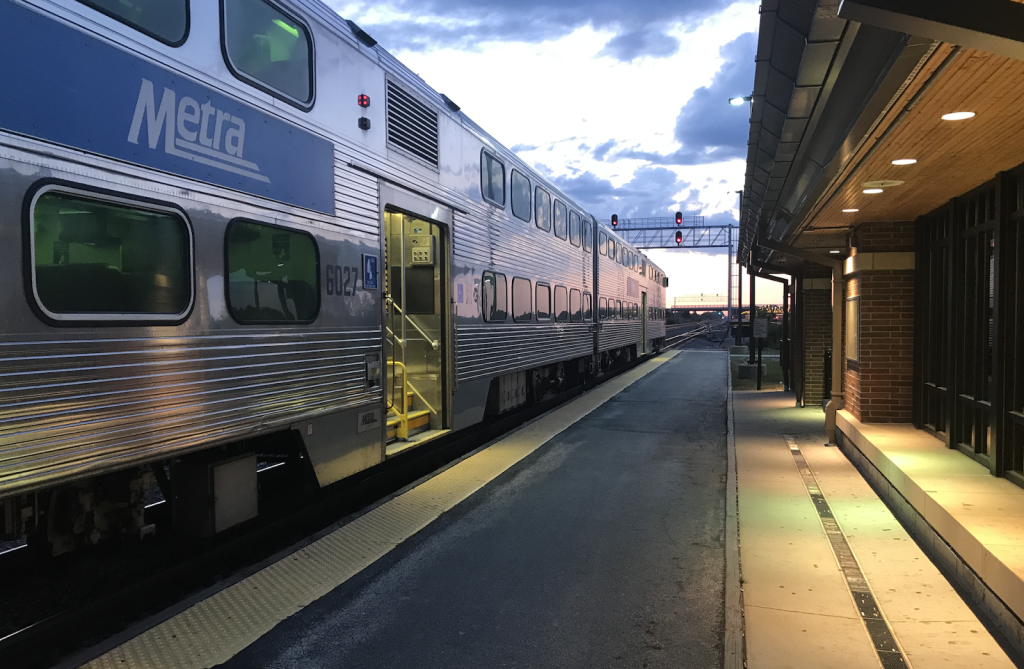
To make ends meet, Wes re-joined the game industry and found a job as an environment artist in downtown Chicago at Robomodo, a game development studio. Each day, he commuted two hours each way via train door-to-door. With all of this idle time, he began working on CG Cookie, launching the first version of the site in September 2008.
One Became Two
Shortly after Wes launched CG Cookie I (Jonathan) discovered the site and proposed to create a Blender tutorial. Wes was unfamiliar with Blender in anything but name and had never met me, yet he said yes.
This would mark the beginning of a long and continuing partnership between Wes and I.
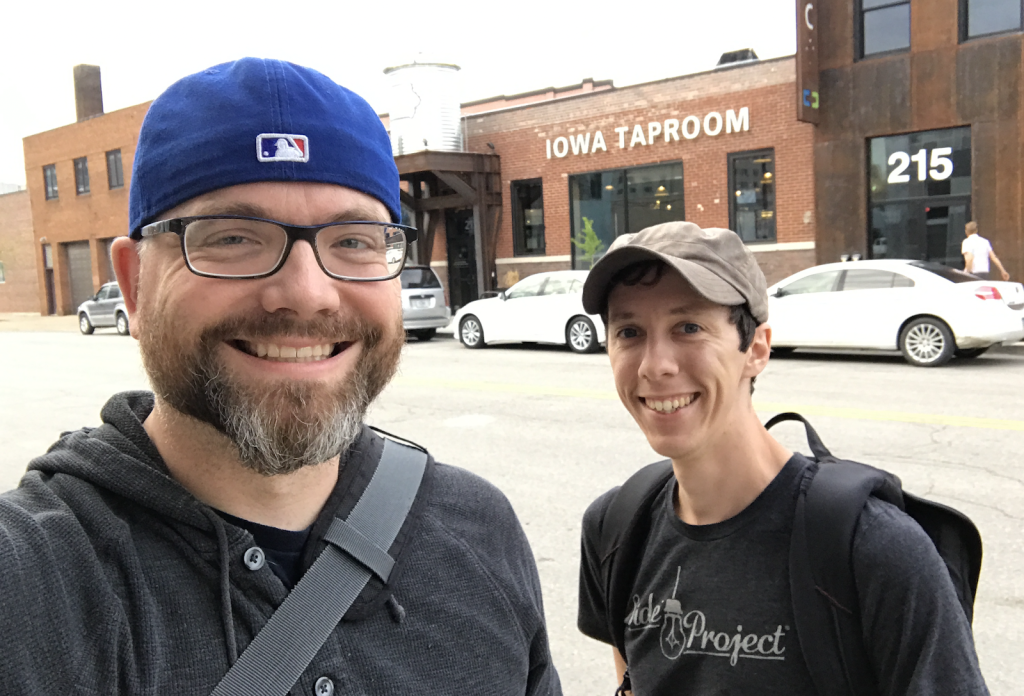
We have come a long way since those early days. There have been countless projects, failed ideas, long nights, impossible deadlines, many tears, and yet through it all we’ve continued to chart our own course to the best of our ability.
This is the story of our journey, much of which has never been publicly shared.
The early years of CG Cookie and Blender
At about one year into CG Cookie, while still commuting four hours a day for work, Wes tapped out his personal resources. He believed deeply in CG Cookie’s future but was still struggling financially. The website was barely making any money at that time and was at risk of being shut down. Around this time the Blender 2.5 project was announced to completely overhaul Blender’s user interface and much of the core architecture.
Blender didn’t have the audience it does today at that time, it was still the black sheep of the CG world. What it had, though, was a dedicated fanbase that was desperately lacking educational resources. Within one year of launching the first Blender tutorial, it quickly became clear that Blender was driving the vast majority of CG Cookie web traffic.
Having run out of resources and fearing we’d have to shut down CG Cookie, we chose to take a gamble. We decided to create a 25+ hour Training DVD series for Blender 2.5, which didn’t yet exist. After launching pre-orders late one night we went to bed hoping a few would sell.
The next morning we woke up to 30+ copies in the first 24 hours, giving us the short-term cash and mental boost needed to keep going. ❤️
Unfortunately, the development of Blender 2.5 would take much longer than expected, not being released for nearly another year, delaying our training series along with it. Would customers demand refunds? Would 2.5 ever be done? Could we hang on another month? In hindsight it was fortunate that I was a college kid with very few expenses.
Despite these challenges, the series was eventually released to great success, setting the stage for future growth.

While working on the Blender 2.5 series we embraced the organic traffic coming to us for Blender content, taking what we’d learned with CG Cookie and we went to work on a dedicated Blender site, launching Blender Cookie in October 2009.
DVDs, Brick and Mortar, Oh my!
While our roots began remotely, Wes and I finally met in person for the first time in 2010. The day we met was the day we signed the paperwork to become partners through the legal incorporation of CG Cookie, Inc.
This is also when we began scouting for a brick and mortar studio in Geneva, IL, allowing us to collaborate in person. Back then, it just felt like what you were supposed to do, so we did it. 🤷♂️

Back then, we mainly were making ends meet by selling DVDs and occasionally taking on contracted studio work, including projects like the mobile game In Time. But we believed there must be a better, more sustainable path.
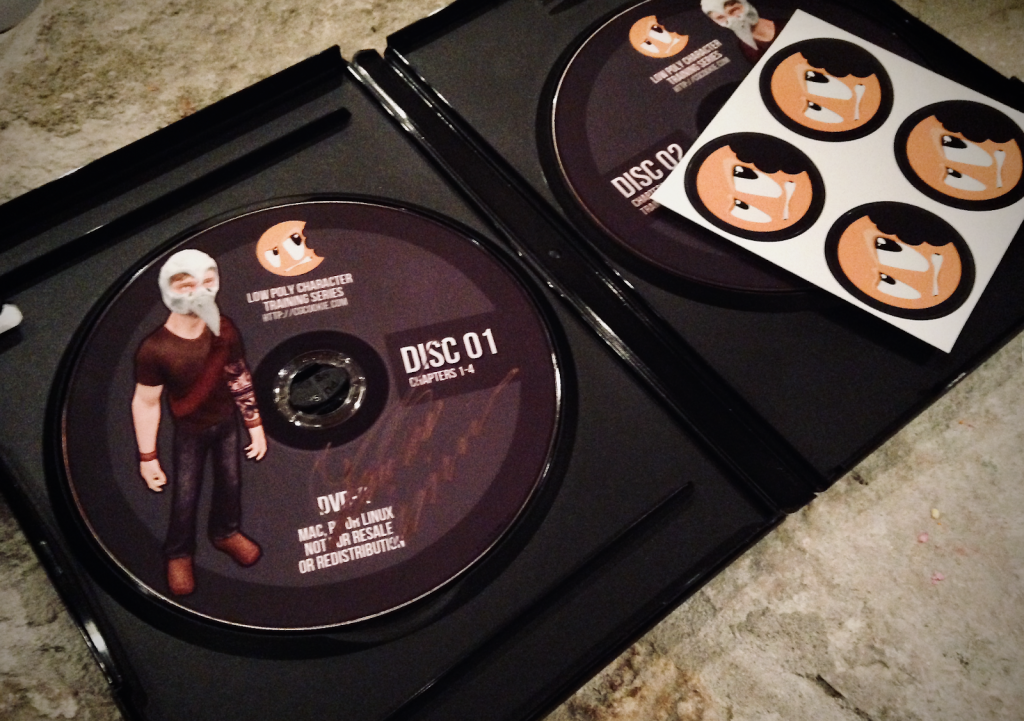
We decided to lean into the idea of offering a recurring subscription to cgcookie.com, through our newly named Citizen membership.
Recurring memberships weren’t all that common in 2010 and I believe we were the first in the Blender space. Most of the feedback was positive, but as a young open-source community, there were definitely hurdles.
However, the strategy proved effective, allowing us to expand the company and team gradually.
Branching Out-Beyond Blender
Over the next few years we would go on to launch Concept Cookie, Max Cookie, Modo Cookie, Sculpt Cookie, and Unity Cookie.
Each of these were dedicated sites within the greater CG Cookie ecosystem to focus on their specific niches of concept art, 3DS Max training, Modo training, traditional clay sculpting, and Unity game engine tutorials.
Fast forward to 2012 and with a small team working with us we began to get the creative itch to create something of our own. We began concepting a passion project that allowed us to explore new outlets via our own iPad game.
With the help of our small team and after many months (years?) of work, we launched Eat Sheep, a silly little game where monsters eat the escaping sheep from the evil wranglers. If I’m not mistaken, we made a modest few hundred dollars from it, but it was damn fun.
2013 was also the first year CG Cookie had a presence at Blender’s SIGGRAPH booth in Los Angeles. Here, we were able to volunteer at the booth, bringing along much of our team to help introduce industry professionals to Blender.
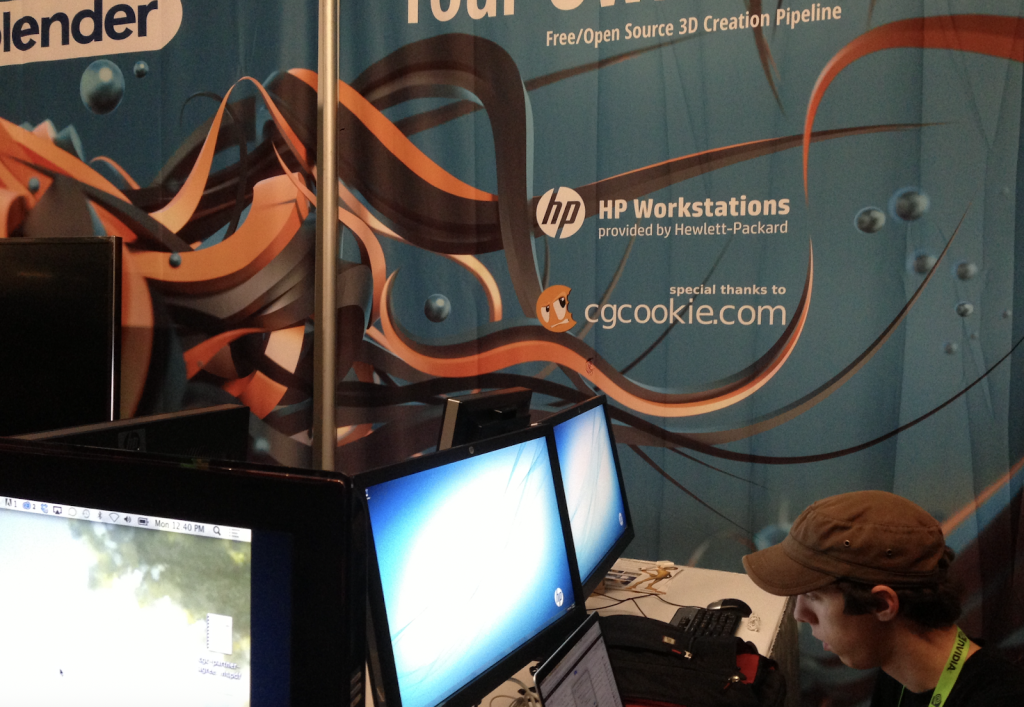
Over the next few years, we would keep creating, staying mostly focused on education, experimenting with live workshops, tiny tip videos, beginner-focused content, advanced deep dives, you name it.
Towards the end of 2013… a new itch started to scratch.
Branching Out-Beyond Education
At this time in the Blender community, there was a constant challenge for both users and developers. Blender was being developed so quickly that add-ons – custom tools for extra functionality – for Blender would constantly break.
Nearly all development, for both Blender and add-ons, was done by volunteers and inevitably, add-ons would constantly break with each new release of Blender. The pace of Blender’s development was such that new releases came out every couple of months.
Offering these add-ons on a volunteer basis, while good in spirit, frequently led to creator burnout or an inability to dedicate the necessary time to maintain the tool's quality within the community.
Picking up on the shared frustrations amongst users (ourselves included) we believed there was an opportunity to establish more sustainable development practices by simply selling open-source licensed add-ons for a small fee. The code would be free, but the support and continued updates would require a reasonable fee.
To this end we decided to test the waters by developing a tool of our own that I had been imagining for a while. We released Contours in 2013, a retopology tool that we announced at SIGGRAPH. I’d been envisioning it for a while and opted to release it as one of the first commercial Blender add-ons, testing the waters for commercial add-on development.
The Contours add-on exceeded all expectations. Realizing we had tapped into a much larger community need, we began working on a project that would prove to change the very course of CG Cookie and perhaps the Blender community as a whole.
Building BlenderMarket.com
Beginning in the Winter months of 2014, with a core team of artists and developers, we began to design and build a three-party marketplace dedicated to Blender.
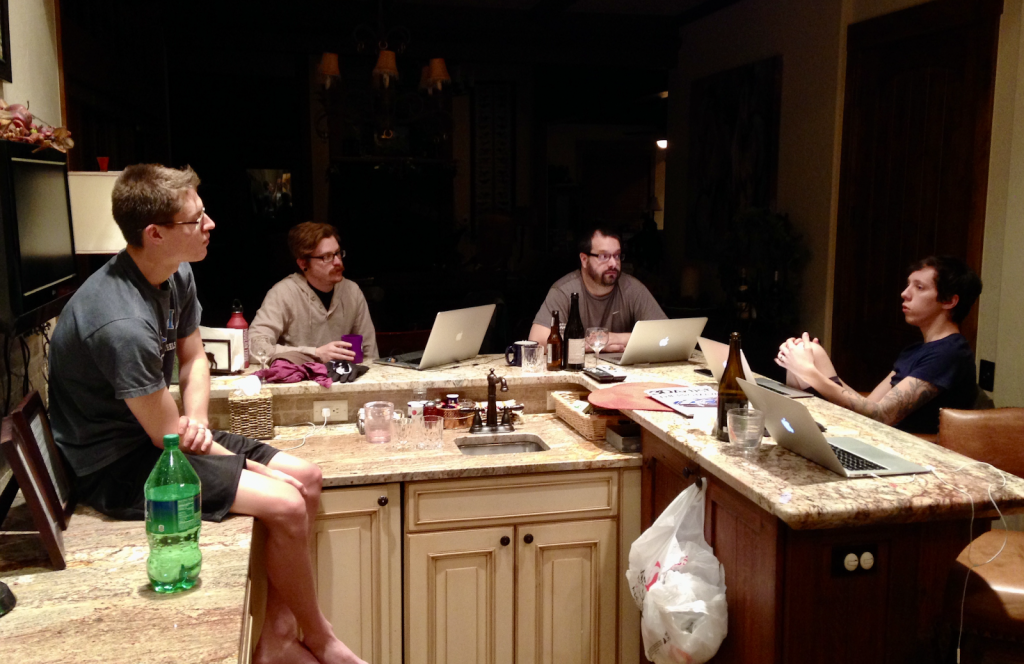
On June 10th of 2014 we launched Blender Market, the first marketplace dedicated to the Blender community.
Those first months and years grew steadily, helped along by our own products. A few months after launching Blender Market we released a second Blender add-on, Polystrips. This add-on later merged with Contours, becoming a singular product, RetopoFlow, which is still available to this day.
The first year of Blender Market required substantial time and money but it wasn’t yet turning a profit. In fact it would take six years to reach profitability.
Downsizing Our Projects
While we continued to put significant effort into each of the Cookie sites and Blender Market we found ourselves being pulled too many directions. Each of our Cookie sites were effectively a business on their own, each with a unique social identity, newsletter, website, etc. At one point we realized we were actively managing 27+ social media accounts.
It was time to bring things full circle and merge everything back into just CG Cookie via a project we dubbed FIVE (and Blender Market).
Around this time we also made the difficult decision to shut down two of our sites, MaxCookie and ModoCookie. These two sites struggled to ever gain traction and ultimately were retired.
These ended up being two of our first experiences with learning to say no to major projects. Something we’d unfortunately have to do a few more times in the near future.
The years that followed the launch of CG Cookie FIVE proved difficult. At nearly every step we ran into technical hurdles and challenges that finally led us to strike out on our own even more via custom development.
We pivoted away from a highly-customized WordPress install to a custom-built Ruby on Rails application. This custom built application for CG Cookie and Blender Market were our first hands-on experience with Rails; we jumped right into the deep end.
Entering the Unknown
A few years prior to 2018 much of the team had begun working remotely, many of them having never worked in the office.
This came naturally to us as it’s how we started. We chose to fully embrace the remote lifestyle long before COVID forced the world to adopt it. I had recently moved to California for my wife’s job, leaving Wes alone in the office most days.
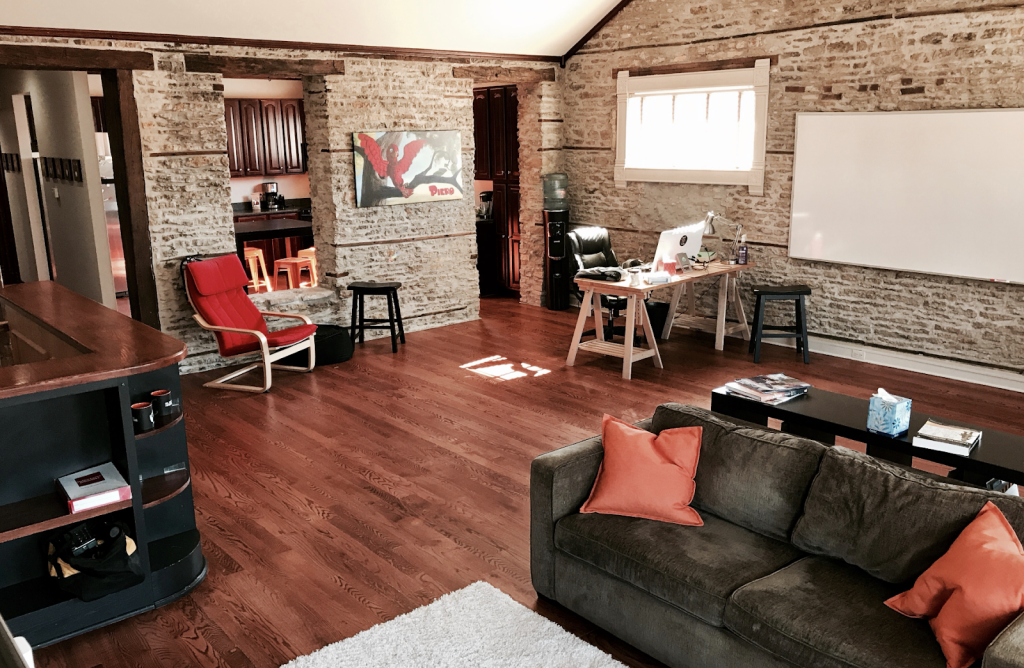
It was around this time too, a full ten years after we started CG Cookie, that we finally embraced what we’d known for a while: we were a Blender company. This was also the beginning of a difficult personal journey for me, as I was burning out.
All of our non-Blender projects were barely treading water and it was time to set them aside for good, with one small yet major exception.
We had constantly been asked over the years about the Learning Management System we used for CG Cookie and the ecommerce solutions for Blender Market. Being fully custom-built by our team we could not help but wonder if we could leverage our infrastructure as a by-product.
Choosing to ignore what we knew, that we were a Blender company, on May 16th 2019 we launched Mavenseed as your solution to sell digital products.
This was a big bet and one that would simply never pan out. Yet it would take us two years to accept the failure. In hindsight we always knew that it wouldn’t work, we were spread too thin, but we weren’t ready to accept our own limitations of focus.
We shut down Mavenseed four years later with nothing but experience to show for it.
A few months later COVID would change everything.
The COVID Roller Coaster Climbs
When COVID caught the world by surprise we found ourselves in a unique situation. We had been working remotely in some form or fashion since 2009 and had embraced it fully a few years before COVID. While most of the world was desperately trying to figure out how to keep working we just kept humming along.
The years during and immediately after COVID were some of the most prosperous of our journey. Turns out having an established remote team that is used to working autonomously on purely digital projects was a good place to be when a pandemic shuts down most of the world.
During the COVID years we doubled down on advanced Blender training, continued to nurture the Blender Market, and began having sincere discussions with the Blender Foundation about balancing trademarks and protecting the Blender name.
The COVID Roller Coaster Drops
It was also around this time that I would hit rock bottom. Having worked incredibly hard for most of my life, motivated out of sheer joy for the work, I found myself rudderless and at a loss for purpose. I was no longer doing the Blender work that defined our early years, nor did I want to, and I was miserable. Perhaps it was paternal postpartum depression or maybe it was the strain of managing hundreds of creator relationships on Blender Market while also trying to nurture our own team. Or maybe it was the distraction of the tiny craft brewery I’d started with my brother a few years before.
Most likely it was all of the above.
Midway through 2021, I would find myself driving to Chicago to discuss selling my stake of the company to Wes. I wanted out, knowing full well I’d not get much for it. All I knew was that I needed a change, but I didn’t understand why. It was only as I was nearing my destination that I made the decision to stay.
I have never been financially motivated. This became abundantly clear to me when I was willing to take pennies on the dollar for my stake simply for a change of pace. What does motivate me is independence and the freedom to make the best decisions I can for the long haul.
This trip would reframe my entire approach to our business and has become the central framework behind all of the major decisions we make.
Going through this experience helped us realize how important the long-term was for us. We have never been interested in short term gains or jumping from one project to another. At fifteen years old our company has already beat the odds, with most startups failing within the first five years.
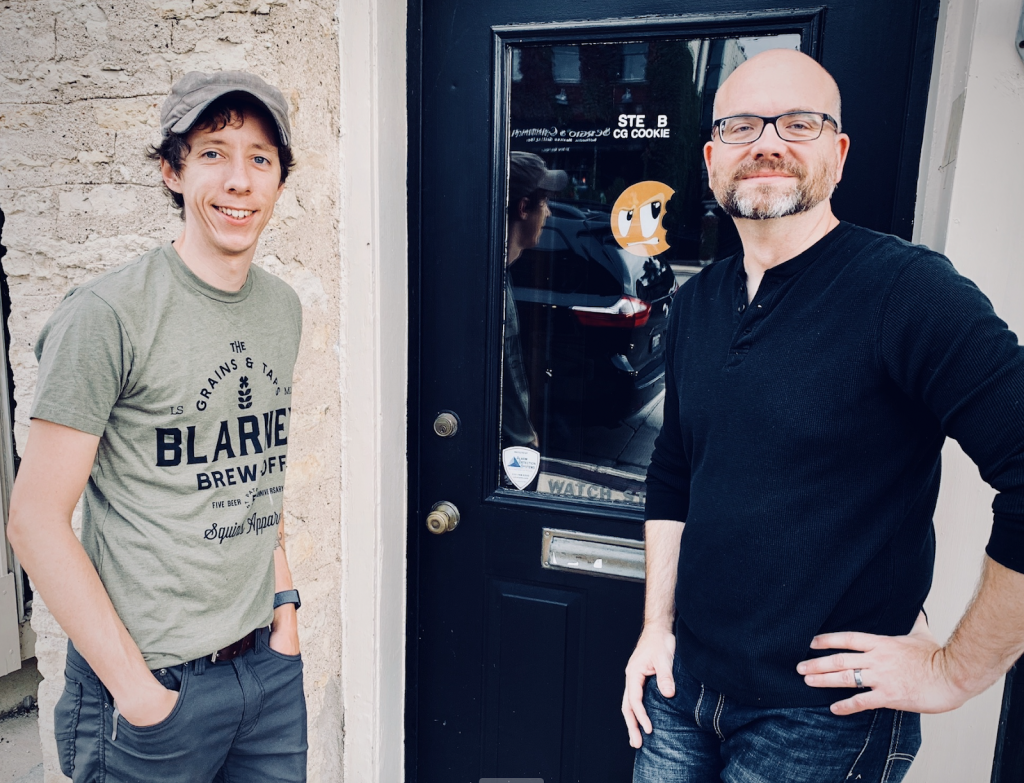
Our goal is to still be here thirty years from now and to still be independent. As a banking partner told us, we are no longer a startup; we are a (gulp), “mature” company. That requires long-term thinking.
As it turns out this mindset would prove critical in the years to come.
Nearly losing everything
Midway through 2022 marked the beginning of our most difficult time as a company. In hindsight it’s easy to recognize that the COVID years were a prime time to run a fully-remote company that focused on exclusively digital content and platforms.
While most of the world was trying to figure out how and where their teams could work we just kept doing what we’d been doing for a decade. The years 2020 and 2021 were among our most prosperous ever.
And yet reality would soon come crashing down.
With five comfortably profitable years in a row we decided to finally invest in the team we needed, not just the team we had. We significantly expanded the team and devoted considerable time to reimagining the structure of our company.
We were determined to grow the team and reduce siloed workflows so that everyone on the team could slow down and catch their breath.
What we failed to anticipate was the post-COVID correction. Over just six months, we would go from earning ~$25,000/month in profit to losing ~$50,000/month. We overinvested and lost a significant portion of our revenue simultaneously.
In 2022, we would lose nearly $200,000 USD, compared to profits of $284,000 the previous year. A swing of almost half a million dollars.
The next year, 2023 we’d lose $195,000, while 2024 would lose $230,000. All in all we would lose well over half a million dollars until we finally righted the financial ship in late 2024.
Over half a million dollars that fell solely on the shoulders of Wes and myself. We’ve been bootstrapped from day one and have no outside investors.
All this while, though, we refused large layoffs. We needed the team and we were dead-set on keeping them, even as it took a major toll on Wes and I’s mental and physical health. At one point I shared with the team how I could physically feel the strain of trying to meet payroll every other week.
Doubling down on people
At any time during our financial “crunch” as we called it, we could have solved the problem overnight. We could have laid off all the people we had just hired and returned to profitability. Yet we refused to do it, we needed the team. How could we claim to be a people-first company if we let people go at the first sign of trouble?
The six years prior to COVID we had run a very lean team, only hiring when it was absolutely essential. This helped us to slowly nurture the culture but made it very difficult to maintain our projects. With only a few exceptions no one had backup; nearly everyone on the team was solely responsible for their work and if they crashed then that work would grind to a halt.
Our significant investment into the team immediately prior to the crunch was intended to solve this. We were finally giving our team the breathing room they desperately needed and had earned many times over.
We didn’t have the appetite to cancel those plans.
Had we re-shrunk our team through layoffs we could have stopped the bleeding in an instant but we’d be right back to where we were. We would again be stretched too thin, perpetually burning out, and unable to maintain the growth of Blender Market, which at the time was doubling every year. Nor would we be able to maintain CG Cookie.
Instead we methodically worked to renegotiate service costs, reduce non-personnel costs, rebalance commission rates on Blender Market, and carefully managed our finances to get back in the black. We barely made it and we’re still working to this day to dig ourselves out of that hole.
It took three years and over a half million dollars in losses but today we’re a much stronger team that truly appreciates what it means to play the long game and to be a people-first company that aims to be here for decades to come.
A new identity
A part of charting our own path and laying foundations for the long haul also included refining our own identity. Having started out as CG Cookie but then introducing Blender Market, Mavenseed, and Orange Turbine we had inadvertently created an incredibly confusing mix of names.
What was CG Cookie the education project and what was CG Cookie the company?
Were team members that worked on Blender Market a part of CG Cookie?
How could we clearly communicate the layers of our company to the outside world if we couldn’t keep it straight internally?
After a few years of constant nagging at the back of our minds we finally found the space to create a new identity that could be the umbrella company for each of our projects, making space for future projects while also allowing each project to nurture its own identity as CG Cookie, Blender Market and Orange Turbine.
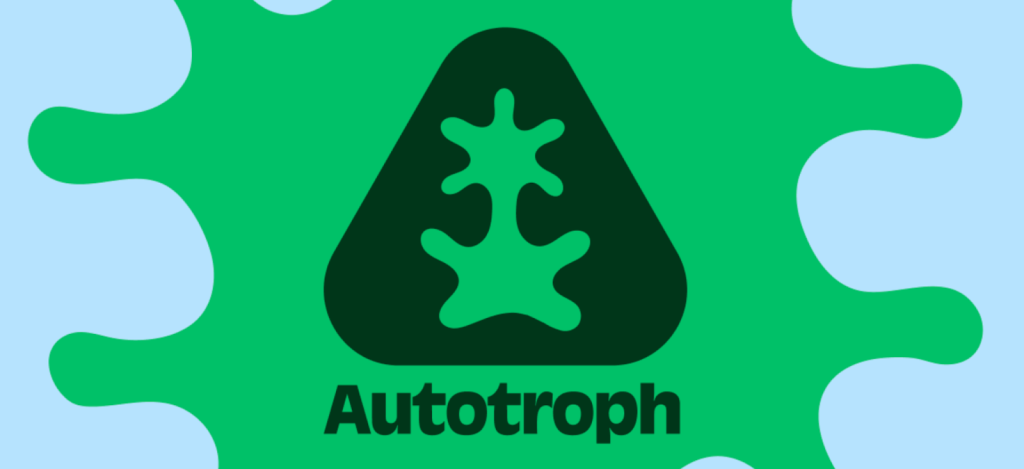
In September 2023 we introduced Autotroph, renaming the parent company that is behind everything we do. Autotroph is the people while the three brands of CG Cookie, Blender Market, and Orange Turbine are the projects. #weareautotroph.
We liked the name from the start, as it refers to organisms that can produce their own food from inorganic substances, using either photosynthesis or chemosynthesis. They are often called "producers", providing sustenance for other organisms, helping others thrive.
We felt this fit our mission to foster and elevate creatives in the Blender community.
Autotroph Brings BCON to Los Angeles
From the very beginning of my work with Blender it was the community that kept me coming back. The Blender community is uniquely special and over the years we have been fortunate to be deeply involved in that community.
Starting in 2010 I began regularly attending the Blender Conference in Amsterdam, which continually cemented for us that the Blender community really is what makes Blender special and has been central to nearly everything we’ve ever done (or at least to those things that were successful). In many software worlds the community is a by-product of the thing. Not so for Blender. The Blender community is the feature that most defines the project. At the end of the day software is just bits and bytes, it is the people that use the software and make up the community that really matter.
On more than one occasion we were asked by the Blender Foundation to consider recreating the Amsterdam conference by hosting a North American version. We loved the idea but were daunted by the work it would require. If we were to do it we wanted to do it right and didn’t believe we were equipped to do that. As time went on, though, after years of saying no we finally said yes in 2023.
Following a full year of planning and a lot of help from the team at the Blender Foundation we hosted the first official Blender Conference outside of Amsterdam in the heart of Los Angeles at The Fonda theater.
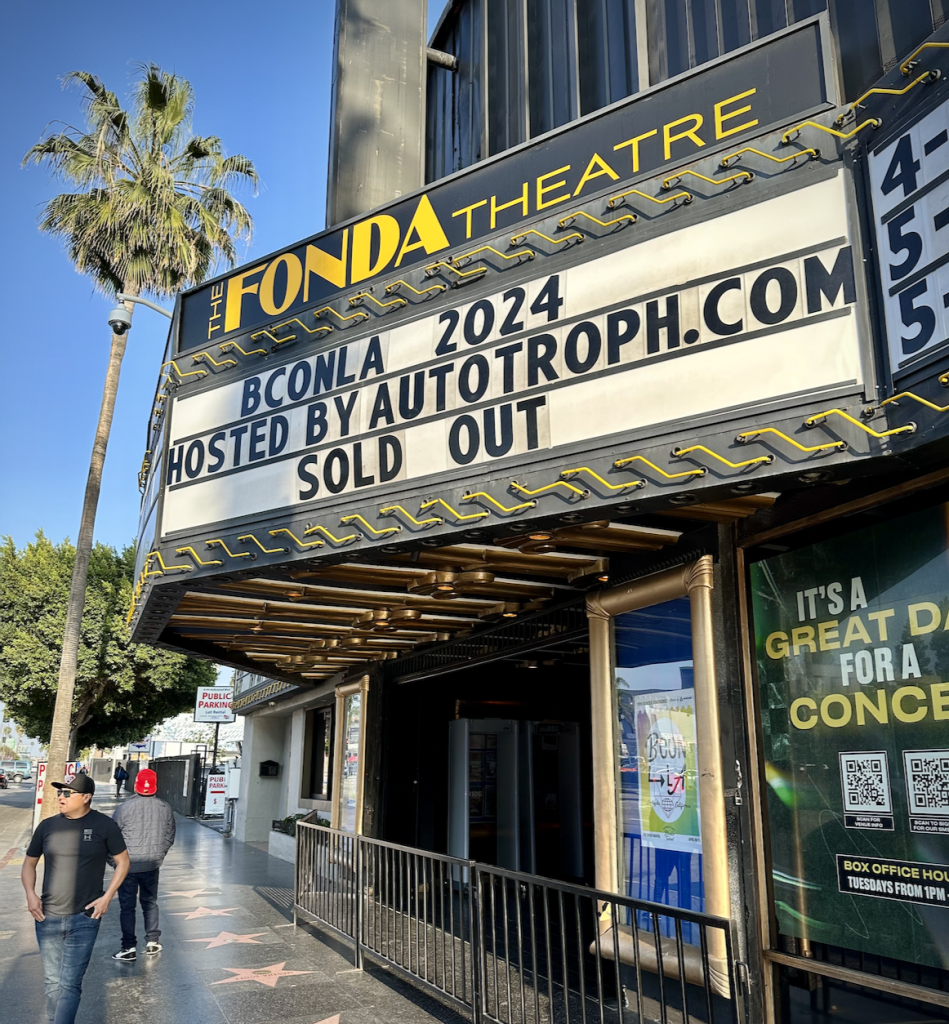
This event renewed our love for the community in a way that is difficult to express. Frequently we express within our team that it’s one of the most important things we’ve ever done.

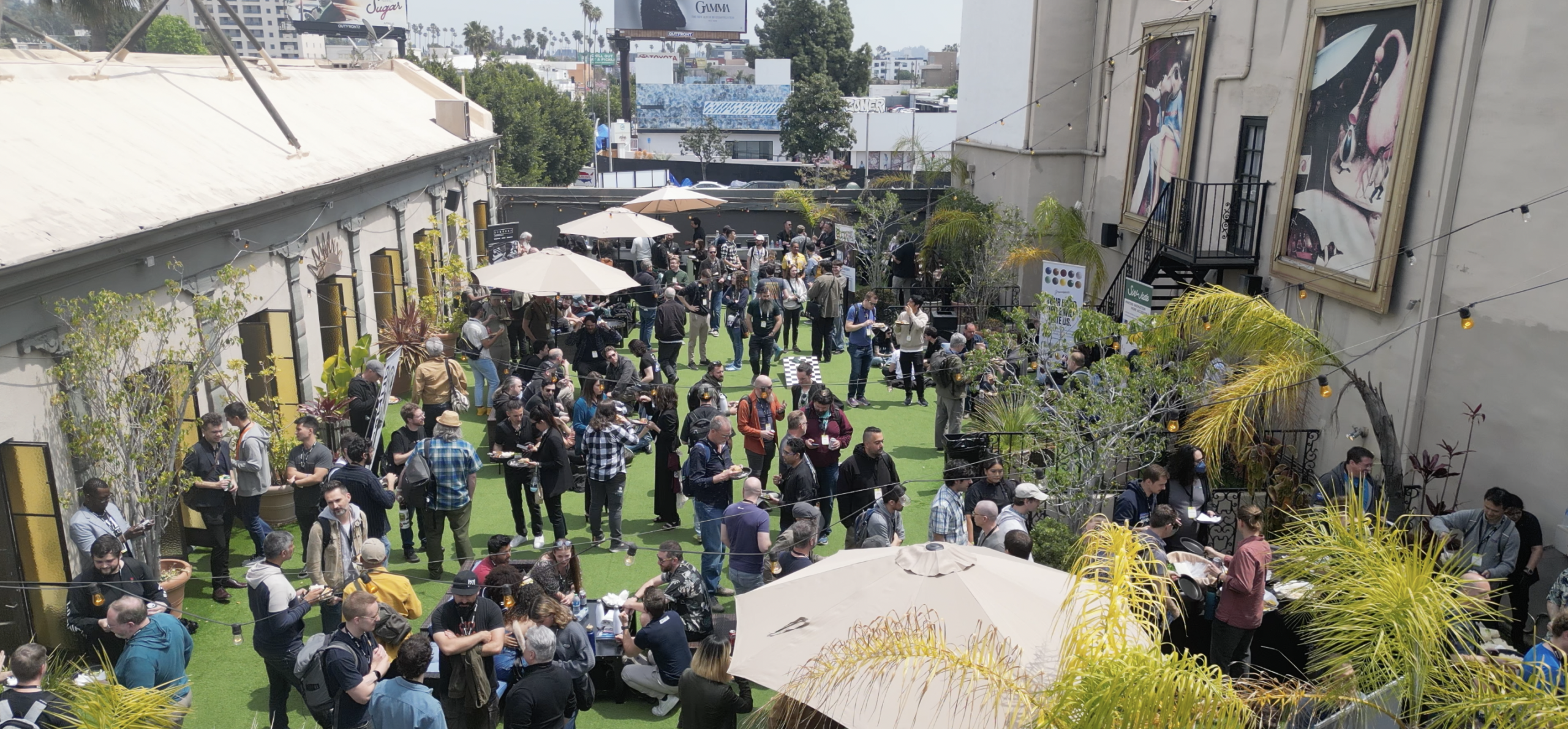
Rediscovering purpose
During BCON LA we announced a name change for Blender Market. Over the previous four years we’d methodically been working with the Blender Foundation to move away from using Blender in the name so as to better protect the trademarked name and to build stronger, more independent brands around Blender.
To this end we launched the rebranded Blender Market, Superhive on April 7th of 2025.
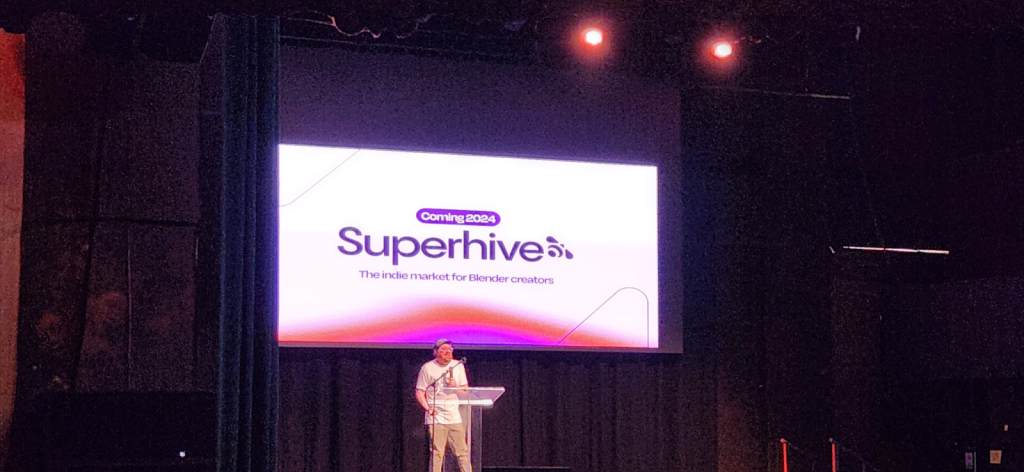
The process of renaming a ten-year-old business is a daunting process. Will people accept the name? How will our customers react? Is Google going to nuke our SEO rankings that took a literal decade to build up?
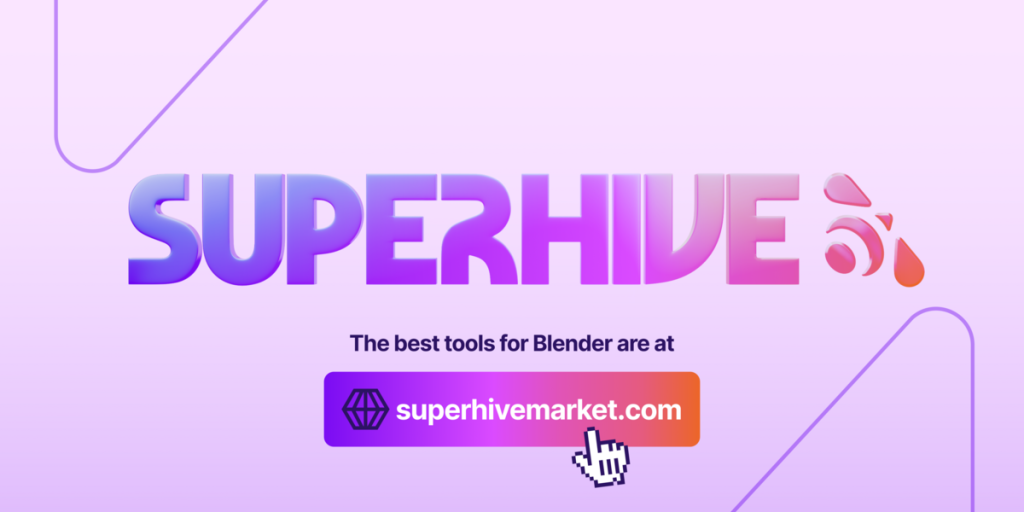
The best part of renaming a business is that it forces you to dig deep and to better understand what actually makes the business work.
The worst part? The doubt. Without a doubt. Hah!
The journey continues
No story happens overnight. It is the culmination of many small events, lots of help, and persistence that dictate the journey.
Our goal with Autotroph is to build long-term livelihoods for our team and the Blender community. It is only when we look back on our last seventeen years, such as when writing this very blog post, that we recognize how far we’ve come and how far we have yet to go. 🙏
I don’t know what the future holds but I know that we’re going to take it one day at a time at Autotroph and that we’re going to keep working towards building a responsible company that treats its people right and aims to be here for decades to come.
Thanks for being on the ride.
